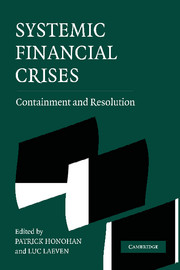Book contents
- Frontmatter
- Contents
- Contributors
- Foreword
- Acknowledgments
- PART ONE INTRODUCTION
- PART TWO CONTAINMENT AND RESOLUTION
- PART THREE MODELS AND ECONOMETRIC EVIDENCE
- PART FOUR STRUCTURAL REFORMS
- 7 Financial Crises and the Presence of Foreign Banks
- 8 Maximizing the Value of Distressed Assets: Bankruptcy Law and the Efficient Reorganization of Firms
- 9 Crisis Resolution and Credit Allocation: The Case of Japan
- Appendix: Banking Crisis Database
- References
- Index
9 - Crisis Resolution and Credit Allocation: The Case of Japan
Published online by Cambridge University Press: 24 August 2009
- Frontmatter
- Contents
- Contributors
- Foreword
- Acknowledgments
- PART ONE INTRODUCTION
- PART TWO CONTAINMENT AND RESOLUTION
- PART THREE MODELS AND ECONOMETRIC EVIDENCE
- PART FOUR STRUCTURAL REFORMS
- 7 Financial Crises and the Presence of Foreign Banks
- 8 Maximizing the Value of Distressed Assets: Bankruptcy Law and the Efficient Reorganization of Firms
- 9 Crisis Resolution and Credit Allocation: The Case of Japan
- Appendix: Banking Crisis Database
- References
- Index
Summary
INTRODUCTION
An incompletely resolved financial crisis can damage economic performance for years. After the bursting of the bubbles in stock prices and real estate prices at the beginning of the 1990s, Japanese economic performance deteriorated markedly, and has yet to recover the vigor that it exhibited for most of the postwar era. Why the Japanese economy has continued to stagnate and been unable to escape its persistent malaise has been the subject of considerable controversy. Although many have argued that resolving the banking crisis and repairing the damaged financial system are critical to the Japanese economic recovery (Greenspan 1999), others have argued that the essential problem is a liquidity trap rather than problems in the banking sector (Krugman 1998).
Determining the nature of the underlying problems is essential, as the appropriate policy prescriptions for these two alternatives are quite different. If the problems center on the banking crisis, then government needs, for example, to recapitalize banks, encourage new entry by well-capitalized foreign banks, and restore liquidity to the real estate market (Chapter 2, this book). Presuming that the problem is primarily a liquidity trap, Krugman (1998) advocates that the Bank of Japan should credibly commit to pursue an inflationary policy for periods “of at least a decade.” With such different solutions being proposed, it is essential to understand whether Japanese banks are a key factor in the prolonged economic malaise experienced in Japan.
- Type
- Chapter
- Information
- Systemic Financial CrisesContainment and Resolution, pp. 276 - 306Publisher: Cambridge University PressPrint publication year: 2005
- 3
- Cited by



